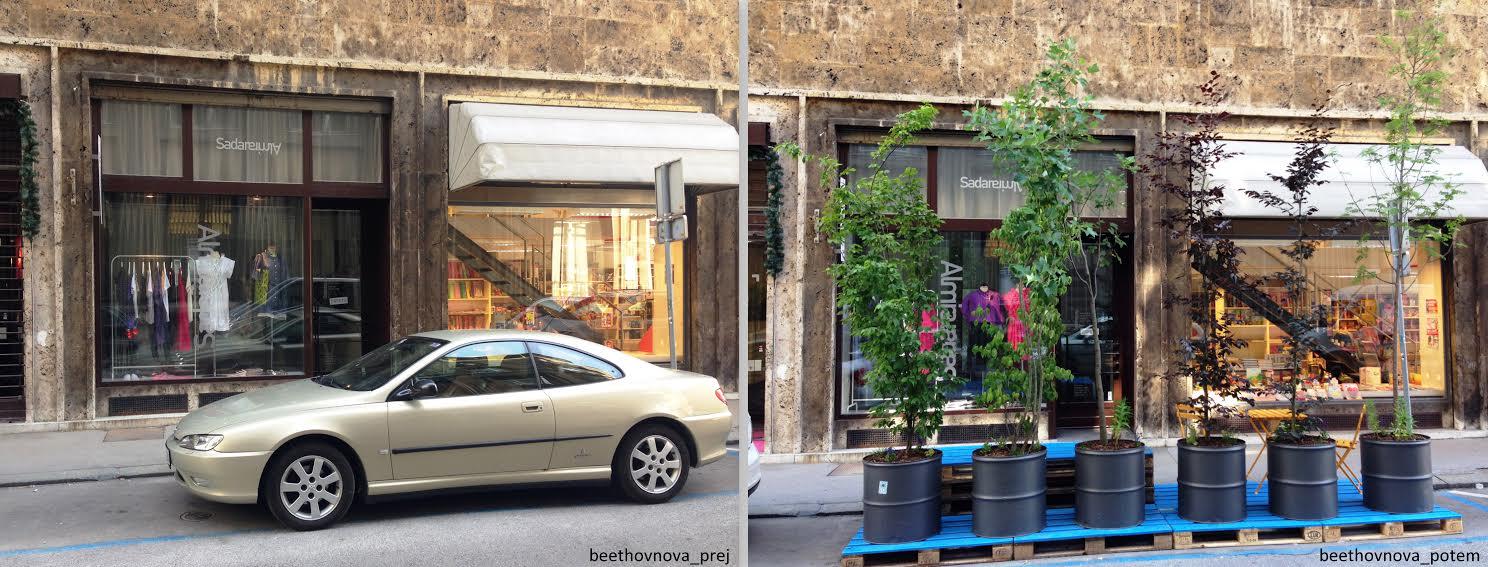


In Ljubljana you can find parklets on the following streets: Rimska, Igriška, Beethovnova, Slomškova, as well as at the Gornji Trg square. They're intended for locals and passers-by who would like have a sit and socialize. Each location was picked upon agreement with someone from those streets, who expressed readiness to take care of the parklets (the Almira Sadar boutique, the Domača Peka bakery, the Bunker non-profit organization, Studio Ag Au, and Studio Kombinat / the ProstoRož association).
A new form of public space
In the frameworks of the Urban Heat Island project, in cooperation with the Municipality of Ljubljana (MOL), the ProstoRož association "took over" streets, otherwise burdened with parking spots and traffic, which failed to offer locals and passers-by a place to sit and socialize. "One of the long-term goals in the traffic strategy of the Municipality of Ljubljana is to reduce the influence traffic has on the environment. That means reducing the number of parking places and increasing the number of people on the streets. By rearranging parking places into "parks" our wish was to take one step closer in that direction and offer a new form of public space," the ProstoRož association explains.
With the project they're also spreading the 3R’s idea: Reduce, Reuse, Recycle. In accordance with the principle of being kind to the environment all the parklets have been created out of recycled material. "The idea at the beginning was to create a mobile park, which would have been set on wheels and could have easily been moved around to different locations. We now see that would have been great. We had quite a few design ideas, as we tried to find something which was cost satisfactory. At the same time the design had to enable more solutions and offer us the chance to test the public space. At the end we settled for a compromise. We used material which was used for the temporary rearrangement of Slovenska Street - palettes, pots with greenery, chairs and little tables," say the "prostoroževci".
The old palettes from Slovenska Street, together with some new palettes, were sanded, painted and put together with metal supporting constructions by the KPL company. Fitting the palettes and transporting some of the already planted trees was also the work of KPL. The Omorika company took care of all the remaining trees and planting boxes which had to be additionally bought, as well all the additional planting.
Different reactions
Have the initiators of the idea received any positive feedback? Were there any negative reactions about the lack of space for cars? "We've had very different reactions, both at the "conflict areas", as well through social networks. It's just as it is with everything; some were thrilled to see the street come to life with the interventions, some others were horrified over the aesthetics, and others again accused us of taking away their parking places. The advantage of setting up these spots is that they can adapt to the reactions of people and they can test the space they're in. And by signaling to new forms of usage, parklets also make people aware of the precious and quality urban space, that is otherwise taken up by steel."
Will parklets become a regular feature or are they just temporary? "It is a temporary amenity. We just wish to test if people feel a need for more space and less cars on the streets. Parklets can be moved, if needed. This month we might even do so on the initiative of some of the users. On the other hand, most Ljubljana streets have electric and telephone lines, sewage, as well as public lightening cables laid down beneath the concrete. This prevents the normal planting of trees and requires the relocation of all the existing cables into one channel. Greening some of the streets is thus currently possible only by using tree boxes."
At the moment the most successful parklet location is the one in Beethovnova Street. Its users are diverse, from local residents that come to have a drink - as they don’t have balconies and are very pleased about this space in front of their building - to shop assistants and local shop customers. On the other hand on Slomškova and Rimska street there are thoughts about relocating the parklets, as some residents have already begun signing petitions against them. However on the very first day on Rimska street, the owner of the neighbouring inn greeted them with enthusiasm, offering to take care of the park under the condition that it remains open for public.


































































